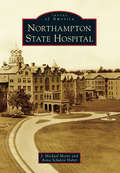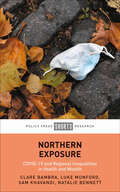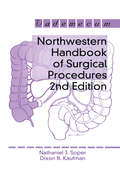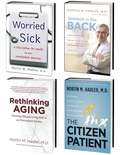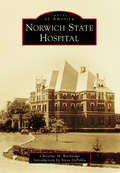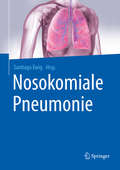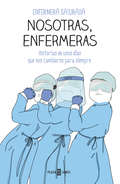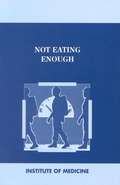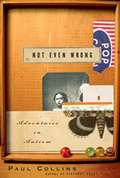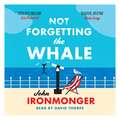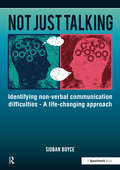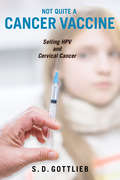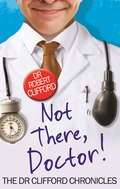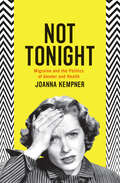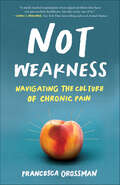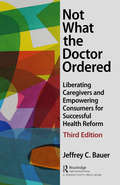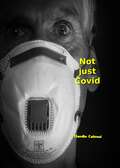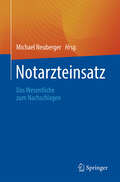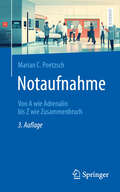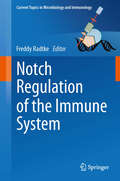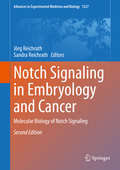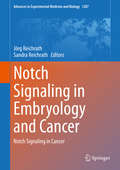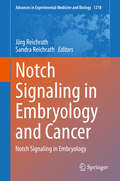- Table View
- List View
Northampton State Hospital
by J. Michael Moore Anna Schuleit HaberNorthampton State Hospital, established in 1856, was built with the optimistic spirit of humanitarian reform. For many years, it was run by Dr. Pliny Earle, a champion of treatment that combined individualized care with manual labor, religious worship, recreation, and amusement. This vision was overwhelmed as the hospital was called upon to care for ever-larger numbers of people with varying needs. By the mid-20th century, the hospital was an isolated small "city," with hundreds of employees caring for more than 2,000 patients in overcrowded and inadequate conditions. It became a nationally important center of political and legal struggle over the role of state hospitals in the care of the mentally ill. After being gradually phased out, the hospital was closed in 1993, and the buildings, though listed in the National Register of Historic Places, were demolished in 2006. This volume brings to life the 135-year story of Northampton State Hospital through beautiful and haunting photographs drawn from the collections of Historic Northampton, the city's local history museum.
Northern Exposure: COVID-19 and Regional Inequalities in Health and Wealth
by Clare Bambra Luke Munford Sam Khavandi Natalie BennettEPDF and EPUB available Open Access under CC-BY-NC-ND licence. Whilst the COVID-19 pandemic affected all parts of the country, it did not do so equally. Northern England was hit the hardest, exposing more than ever the extent of regional inequalities in health and wealth. Using original data analysis from a wide range of sources, this book demonstrates how COVID-19 has impacted the country unequally in terms of mortality, health care, mental health, and the economy. The book provides a striking empirical overview of the impact of the pandemic on regional inequalities and explores why the North fared worse. It sets out what needs to be learnt from the pandemic to prevent regional inequality growing and to reduce inequalities in health and wealth in the future.
Northwestern Handbook of Surgical Procedures
by Richard H. Bell Jr.The Northwestern Handbook of Surgical Procedures, 2nd Edition, is designed to be reviewed prior to performing or participating in an operation. The authors of the book have identified the key steps of performing each procedure, to provide a framework to the learner for understanding the tasks and the sequence of those tasks necessary for successful
Nortin Hadler's 4-Volume Healthcare Omnibus E-Book
by Nortin M. HadlerThis four-volume Omnibus E-Book is a collection of Nortin Hadler's definitive works on the state of healthcare in America today. The set includes:Worried Sick: A Prescription for Health in an Overtreated America, Hadler's best-seller that shows consumers how to distinguish good medical advice from persuasive medical marketing, make better decisions about their personal health, and use that wisdom to inform their perspectives on health-policy issues. This Omnibus includes the new preface by the author and a new foreword by Shannon Brownlee and Jeanne Lenzer;Stabbed in the Back: Confronting Back Pain in an Overtreated Society, takes the "Hadlerian" approach to backaches and the backache treatment industry, arguing that regional back pain is overly medicalized by doctors, surgeons, and alternative therapists and that the design of workers' compensation, disability insurance, and other "health" schemes actually thwarts getting well; andRethinking Aging: Growing Old and Living Well in an Overtreated Society, in which Hadler offers a doctor's perspective on the medical literature as well as his long clinical experience to help readers assess their health-care options and make informed medical choices in the last decades of life.And, in Dr. Hadler's newest, The Citizen Patient: Reforming Health Care for the Sake of the Patient, Not the System, he urges American health-care consumers to take time to understand the existing system and to visualize what the outcome of successful reform might look like. Central to this vision is a shared understanding of the primacy of the relationship between doctor and patient. Hadler shows us that a new approach is necessary if we hope to improve the health of the populace. Rational health care, he argues, is far less expensive than the irrationality of the status quo.This invaluable set -- collected here for the first time in a 4-volume Omnibus E-Book, is a must have for anyone interested in navigating the complex issues surrounding their healthcare, and improving their well-being as they age.
Nosokomiale Pneumonie
by Santiago EwigDieses Buch bietet differenzierte Diagnostik und Therapie – was, wann, warum - zur sofortigen sicheren Anwendung entsprechend der neuesten Studien und Leitlinien aller wichtigen deutschen, europäischen und amerikanischen Fachgesellschaften. Zudem umfasst es die Darstellung der aktuellen Hygienekonzepte zur Prävention, die angesichts der Verbreitung multiresistenter Erreger immer wichtiger erscheinen. Grundlagen· Geschichte· Epidemiologie, HAP und VAP· Pathologie· Pathophysiologie und Pathogenese· Mikrobiologie: Methoden und wichtigste Erreger· Mikrobielle Resistenzen(Differential-)Diagnostik, Prognose· Klinische Symptomatik und Untersuchungsbefunde· Radiologische Bildgebung· Labordiagnostik· Mikrobiologische Diagnostik· RisikobeurteilungTherapie · Grundlagen der antimikrobiellen Therapie· Kalkulierte und gezielte antimikrobielle Therapie· Adjunktive Maßnahmen Komplikationen· Therapieversagen· RezidiveVentilator-assoziierte Tracheobronchitis (VAT)Besonderheiten definierter Populationen· Postoperativ· Nach thoraxchirurgischen Eingriffen· Nach herzchirurgischen Eingriffen· Trauma· NeurologieLeitlinien· Entwicklung· Übereinstimmungen und UnterschiedePrävention· Surveillance · Gesicherte Präventionsstrategien und - maßnahmen
Nosotras, enfermeras: Historias de unos días que nos cambiaron para siempre
by Enfermera SaturadaEl testimonio de cómo las enfermeras vivimos los días en que un virus paralizó el mundo en poco más de tres meses y sumió a España en la peor pandemia del siglo XXI. Esta es la historia de una enfermera que luchó contra el coronavirus en primera línea, armada con una bolsa de basura y una mascarilla reutilizada. Pero, en realidad, es también la de todos los enfermeros y las enfermeras que plantaron cara al virus, esos a los que la sociedad llamó héroes, y por quienes aplaudía a las ocho, mientras ellos y ellas vivían con el miedo pegado a su espalda. Es el testimonio de sus lágrimas, temores y sacrificios, y a la vez de la inmensa felicidad que sentían cada vez que apagaban un respirador y entregaban el alta a un paciente. «El primer paciente que atendí con la COVID-19 fue el 5 de marzo de 2020. Creo que esta será una de las fechas que recordaré toda la vida. Hasta ese día, hasta el mismo instante en que tienes frente a ti a una persona contagiada con el virus que está causando tantos estragos, mis compañeras y yo seguíamos pensando que no nos tocaría. Supongo que una, como mecanismo de defensa, tiende a negar la realidad hasta que la tiene a dos metros de distancia y con un informe del laboratorio con la palabra POSITIVO escrita en mayúsculas. A pesar de todo, y aunque los casos en Italia se contaban ya por miles, seguíamos aferrándonos al hecho de que ese día en nuestro país los confirmados apenas superaban los doscientos y en las plantas de mi hospital los casos no llegaban ni a media docena. No podíamos ni imaginar que acabaríamos ingresando, únicamente en nuestra unidad, a más de trescientos pacientes en solo dos meses. Que en toda España habría más de doscientos cincuenta mil casos confirmados, que en apenas tres meses más de cincuenta mil compañeros y compañeras se contagiarían o que nos dejarían para siempre más de veintiocho mil personas según los datos oficiales. Con este libro pretendo plasmar, de la forma más fiel posible a la realidad, todas las historias acontecidas durante estos meses para que, a pesar del paso de los años, no se pierdan en el olvido, se reescriban o se desdibujen. Así, quienes no lo han vivido tan de cerca, podrán ser más conscientes de lo que sucedió.» «La crónica de un enorme esfuerzo profesional, escrita desde la solidaridad y la angustia. Leerlo es un acto de gratitud». PEPA FERNÁNDEZ.RNE
Not Eating Enough: Overcoming Underconsumption of Military Operational Rations
by Committee on Military Nutrition ResearchEating enough food to meet nutritional needs and maintain good health and good performance in all aspects of life--both at home and on the job--is important for all of us throughout our lives. For military personnel, however, this presents a special challenge. Although soldiers typically have a number of options for eating when stationed on a base, in the field during missions their meals come in the form of operational rations. Unfortunately, military personnel in training and field operations often do not eat their rations in the amounts needed to ensure that they meet their energy and nutrient requirements and consequently lose weight and potentially risk loss of effectiveness both in physical and cognitive performance. This book contains 20 chapters by military and nonmilitary scientists from such fields as food science, food marketing and engineering, nutrition, physiology, psychology, and various medical specialties. Although described within a context of military tasks, the committee's conclusions and recommendations have wide-reaching implications for people who find that job-related stress changes their eating habits.
Not Even Wrong: A Father's Journey Into the Lost History of Autism
by Paul CollinsIn Not Even Wrong, Paul Collins melds a memoir of his son's autism with a journey into this realm of permanent outsiders. Examining forgotten geniuses and obscure medical archives, and beginning to see why he himself has spent a lifetime researching talented eccentrics, Collins shows how these stories are relevant and even necessary to shed light on autism.
Not Forgetting The Whale: The International Bestseller
by John IronmongerTHE STORY OF A MAN WHO HAD GIVEN UP HOPE......AND THE VILLAGE THAT GAVE IT BACK TO HIM 'Forget everything you know about apocalypses: this novel, set in Cornwall, will restore your faith in humanity' Elle UK'A gentle and uplifting tale of warding off apocalypse in a remote corner of Cornwall' Financial Times'As the front pages crowd with headlines that grow ever more grim, Not Forgetting the Whale offers a very welcome alternative' IndependentWhen a young City trader, Joe, washes up on the sands of St Piran in Cornwall, warning of a deadly pandemic virus and a financial apocalypse, he is rescued by the villagers, and given a home. From the retired village doctor and the beachcomber, to the priest's wife and the flamboyant romantic novelist, they take this lost soul into their midst. The village, Joe tells them, must store up food, and isolate themselves to stay safe. But are Joe's fears unfounded? Why has Joe fled the city for St Piran? And what of the whale that lurks in the bay?Intimate, funny and heart-warming, Not Forgetting the Whale is a story about a community reacting to a deadly threat, about the best and worst in our nature - and the search for a place to call home(p) 2015 Orion Publishing Group
Not Just Talking: Identifying Non-Verbal Communication Difficulties - A Life Changing Approach
by Sioban BoyceThis innovative approach to dealing with communication difficulties was devised by the author following encounters with increased numbers of children who had learned to talk, but still were unable to communicate effectively. This new theory of communication development devised in the late 1990s has been successfully used by the author and a wide range of educators and promotes the good use of non-verbal skills in children. This programme changes the lives of the children (in the family and at school) who benefit from it. The book will look at: Non-verbal communication theory; Normal and disordered development; Problems arising - behaviour; social skills; emotions; education; in the family; Prevention; Assessment; and, Intervention. Generally those children with poor non-verbal skill development will have limited ability to communicate effectively in all situations and may even be 'shut down', i.e not attempting to communicate unless they choose to. This flagship book provides a whole new perspective and presents a concrete alternative approach to tackling the fundamentals from which communication difficulties arise.
Not My Shame: A memoir of trauma, taboos and the path to healing
by Martina ZanggerA testament to the power of female courage and strength, this intensely personal memoir reveals how one woman confronted her dark past and broke free from lifelong trauma bonds. Not content with only healing herself, author Martina Zangger has dedicated her life to helping other sexual assault survivors as they navigate both their healing journeys and the complexities of the criminal justice system. Her frankness in narrating her startling life choices displays the potency of shedding shame and the freedom that follows. Sexually abused by her grandfather and uncle as a small child, Martina&’s early years became the foundation for a life of struggles and wrong turns. Like many victim survivors, Martina kept her trauma a secret—a suppression that led her into sex work and ultimately into the grip of the notorious cult of the Indian guru Rajneesh. For decades, Martina believed she was a magnet for abusers; that the sexual violence she endured was somehow her fault. But healing has allowed Martina to bravely face the tragedies she once buried, and to place the blame where it belongs. No longer silenced by shame, Martina&’s greatest discovery is that love doesn&’t have to be dangerous, that it can be respectful and kind instead. This is her story, and it is a story of hope for all survivors.
Not Quite a Cancer Vaccine: Selling HPV and Cervical Cancer
by Samantha D. GottliebIn Not Quite a Cancer Vaccine, medical anthropologist S.D. Gottlieb explores how the vaccine Gardasil—developed against the most common sexually-transmitted infection, human papillomavirus (HPV)—was marketed primarily as a cervical cancer vaccine. Gardasil quickly became implicated in two pre-existing debates—about adolescent sexuality and pediatric vaccinations more generally. Prior to its market debut, Gardasil seemed to offer female empowerment, touting protection against HPV and its potential for cervical cancer. Gottlieb questions the marketing pitch’s vaunted promise and asks why vaccine marketing unnecessarily gendered the vaccine’s utility, undermining Gardasil’s benefit for men and women alike. This book demonstrates why in the ten years since Gardasil’s U.S. launch its low rates of public acceptance have their origins in the early days of the vaccine dissemination. Not Quite a Cancer Vaccine addresses the on-going expansion in U.S. healthcare of patients-as-consumers and the ubiquitous, and sometimes insidious, health marketing of large pharma.
Not There, Doctor
by Robert CliffordNot There, Doctor continues the hilarious and heartwarming true story of a young doctor and his patients in the heart of West Country. In the period leading up to Dr Clifford's wedding day, the trials and tribulations of his procession of patients are a source of constant entertainment. There's the angler whose salmon lure ends up embedded in the seat of his trousers; the bridegroom with a tattoo he's desperate to remove before he marries; the pregnant woman whose X-rays reveal a truly amazing phenomenon; and there's the Doctor's own wedding when the bridesmaids appear in transparent dresses and the vicar forgets his lines . . . Dr Clifford's chronicles are a marvellous blend of human laughter, tragedy and courage, tales of a doctor totally at one with his world.
Not There, Doctor (The Dr Clifford Chronicles)
by Dr Robert CliffordNot There, Doctor continues the hilarious and heartwarming true story of a young doctor and his patients in the heart of West Country. In the period leading up to Dr Clifford's wedding day, the trials and tribulations of his procession of patients are a source of constant entertainment. There's the angler whose salmon lure ends up embedded in the seat of his trousers; the bridegroom with a tattoo he's desperate to remove before he marries; the pregnant woman whose X-rays reveal a truly amazing phenomenon; and there's the Doctor's own wedding when the bridesmaids appear in transparent dresses and the vicar forgets his lines . . .Dr Clifford's chronicles are a marvellous blend of human laughter, tragedy and courage, tales of a doctor totally at one with his world.
Not Tonight: Migraine and the Politics of Gender and Health
by Joanna Kempner&“[An] insightful and eloquent account of our evolving understandings of migraine, from a condition of weak-nerved women, to a &‘real&’…disease&” (Elizabeth Mitchell Armstrong Princeton University). Pain. Vomiting. Hours and days spent lying in the dark. Migraine is an extraordinarily common, disabling, and painful disorder that affects over 36 million Americans and costs the US economy at least $32 billion per year. Nevertheless, it is a frequently dismissed, ignored, and delegitimized condition. In Not Tonight, sociologist Joanna Kempner argues that this general dismissal of migraine can be traced back to the gendered social values embedded in the way we talk about, understand, and care for people in pain. The symptoms that accompany headache disorders—like head pain, visual auras, and sensitivity to sound—lack objective markers of distress that can confirm their existence. Therefore, doctors must rely on the perceived moral character of their patients to gauge how serious their complaints are. Kempner shows how this subjective dimension of diagnosis has shaped the history of migraine. In the nineteenth-century, migraine was seen as a disorder of upper-class intellectual men and hysterical women. In the 1940s, the concept of &“migraine personality&” developed, in which women with migraine were described as uptight neurotics who withheld sex. Even today, we see depictions of people with highly sensitive &“migraine brains.&” Not Tonight casts new light on how cultural beliefs about gender, pain, and the distinction between mind and body influence not only whose suffering we legitimate, but which remedies are marketed, how medicine is practiced, and how knowledge about disease is produced.
Not Weakness: Navigating the Culture of Chronic Pain
by Francesca GrossmanAfter thyroid cancer, Crohn’s disease, and a slew of other autoimmune conditions ransacked her body in her twenties and thirties, Francesca was left feeling completely alone in her chronic pain. Constant, relentless, often indescribable, and always exhausting, it affected her whole life—intimacy, motherhood, friendship, work, and mental health. Yet it was also fairly invisible—and because of that, Francesca felt entirely alone in the centrifuge of her own pain. But after twenty-plus years of living this way, isolated and depressed, she started to wonder: if she lived in pain, others must too—so why couldn't she name one person in her community who suffered like she did?On a whim, Francesca started asking women in her community if they had chronic pain—only to find that she was surrounded by women also battling in silence. The more she spoke to people, the more she found common themes and experiences, proving that her stories of pain were not unique, and neither were her feelings of loneliness and seclusion. Liberated by this discovery, Francesca realized something: while she couldn’t alleviate anyone's pain, maybe she could lift the shadows surrounding it—bring these common stories into the light, with the goal of helping her fellow chronic pain sufferers feel a little less alone.Imbued with a deep respect for the women who tell their stories in its pages, as well as a healthy skepticism of the healthcare world and how it can silence, shame, and ignore women in pain, Not Weakness is galvanizing memoir about living and loving with chronic pain.
Not What the Doctor Ordered: Liberating Caregivers and Empowering Consumers for Successful Health Reform (Hfma Healthcare Financial Management Ser.)
by Jeffrey C. BauerThis 25th Anniversary edition completely updates the powerful insights and policy recommendations of Not What the Doctor Ordered, first published in 1993 by renowned healthcare futurist and medical economist the author. It presents specific solutions to serious problems of cost, quality, access, and outcomes by allowing all Americans to purchase services directly from caregivers who provide an expanding array of medical services at least as well as physicians—at lower cost. Focusing on new realities of the 21st century, the authorshows not only why giving consumers the right to choose advanced practitioners is the top priority for improving our overpriced, underperforming medical care delivery system, but also how to make the necessary changes. As he clearly and concisely explains from medical and economic perspectives, the key is eliminating physicians’ monopoly powers over advanced practice nurses, clinical pharmacists, physical therapists, clinical psychologists, and other advanced practice (AP) health professionals who now rival physicians in scientific knowledge and caregiving skills within well-defined scopes of practice regulated by state governments.
Not just covid
by Claudio CalzoniNot just covid There are diseases that take precedence in the media and on social media while many others are set aside and almost forgotten, as if they were temporary and not very debilitating. Claudio Calzoni witnesses one of these through the notes of his diary, full of Poetry and suffering.
Notarzteinsatz: Das Wesentliche zum Nachschlagen
by Michael NeubergerDieses Buch bietet für jeden Notarzteinsatz die wesentlichen Fakten zum Nachschlagen auf den Punkt gebracht. Das Kompendium basiert auf den aktuell gültigen Leitlinien sowie langjährigen Erfahrungen der Autoren in ihren jeweiligen Spezialgebieten und enthält zahlreiche Tabellen und wertvolle Praxistipps. Rasch zum Nachschlagen im Notfall: Reanimation, Atemwegsmanagement, Analgosedierung und Narkose. Besonderes Praxis-Plus sind die vielen Dosierungsangaben für Erwachsene und auch für Kinder. Sowohl angehende Notfallmedizinerinnen und Notfallmediziner als auch erfahrene Notärztinnen und Notärzte finden hier das strukturierte Vorgehen bei den häufigsten präklinischen Notfällen aus allen relevanten medizinischen Fachgebieten.
Notaufnahme: Von A wie Adrenalin bis Z wie Zusammenbruch
by Marian C. PoetzschDieses Buch erläutert amüsant und kurzweilig, worauf man sich bei der Arbeit in der Notaufnahme gefasst machen kann. Für alle, die sich mit der nötigen Prise Humor auf den Dienst vorbereiten wollen oder zwischendurch nochmal nachschauen wollen, was z.B. ein GOMER war.
Notch Regulation of the Immune System
by Freddy RadtkeNotch signaling regulates many cell fate decision and differentiation processes during embryonic development and tissue homeostasis. Moreover, disregulation of the pathway is associated with human disorders and cancer. In the last 15 years it became evident that Notch plays important roles in the hematopoietic system as well as in the regulation of immune responses. This special issue on Notch regulation of the immune system summarizes recent advances and covers multiple aspects of Notch signaling within the hematopoietic and the immune system. This issue covers subjects including Notch function in embryonic and adult hematopoietic stem cells, lymphocyte development and function as well as in T cell leukemia.
Notch Signaling in Embryology and Cancer: Molecular Biology of Notch Signaling (Advances in Experimental Medicine and Biology #1227)
by Jörg Reichrath Sandra ReichrathThis thoroughly revised second edition is an up-to-date overview of the current knowledge of Notch and Notch signaling in embryology and cancer. It summarizes the newest achievements on this topic from Notch’s flag-ship function in the development of the embryo and for various inherited diseases to the Notch signaling pathway’s role in the development of leukemia and in a number of cancers, including skin cancer, intestinal cancer and others. Additionally, the emerging new role of the Notch signaling pathway as a promising target for prevention and therapy of various diseases, including cancer, is discussed. In the years since the previous edition, there have been numerous developments and insights within this rapidly moving field, making this new edition urgently needed. This volume also features discussions of current insights on Notch’s role for embryologic tissue patterning, for stem cells, in senescence, and on the regulation of Notch signaling by epigenetic and other factors including microRNAs, long non-codingRNAs, and more. Taken as a whole, with its companion books – Notch Signaling in Embryology and Notch Signaling in Cancer – this is a definitive discussion of the topic, presented by internationally-recognized contributors. Presented in a coherent and accessible structure, this revised and updated second edition is an essential and up-to-date guide for oncologists, embryologists, researchers and advanced students.
Notch Signaling in Embryology and Cancer: Notch Signaling in Cancer (Advances in Experimental Medicine and Biology #1287)
by Jörg Reichrath Sandra ReichrathThis thoroughly revised second edition is an up-to-date overview of the current knowledge of Notch and Notch signaling in embryology and cancer. It discusses this topic from Notch’s role in the development of the embryo to the Notch signaling pathway’s role in the development of a number of cancers, including breast cancer, malignant melanoma, Non-melanoma skin cancer, intestinal cancer and others. In the years since the previous edition, there have been numerous developments and insights within this rapidly moving field, making this new edition urgently needed. This volume also features discussions of current insights on Notch’s role in senescence, the regulation of Notch signaling by microRNAs, Notch’s role in the microbiome, diet and its influence on Notch signaling and more. Taken as a whole, with its companion books -- Notch Signaling and Embryologic Development and Molecular Basis of Notch Signaling – this is a definitive discussion of the topic, presented by internationally-recognized contributors. Presented in a coherent and accessible structure, this revised and updated second edition is an essential and up-to-date guide for oncologists, embryologists, researchers and advanced students.
Notch Signaling in Embryology and Cancer: Notch Signaling in Embryology (Advances in Experimental Medicine and Biology #1218)
by Jörg Reichrath Sandra ReichrathThis thoroughly revised second edition is an up-to-date overview of the current knowledge of Notch and Notch signaling in embryology and cancer. It discusses this topic from Notch’s role in the development of the embryo to the Notch signaling pathway’s role in the development of a number of cancers, including breast cancer, malignant melanoma, Non-melanoma skin cancer, intestinal cancer and others. In the years since the previous edition, there have been numerous developments and insights within this rapidly moving field, making this new edition urgently needed. This volume also features discussions of current insights on Notch’s role in senescence, the regulation of Notch signaling by microRNAs, Notch’s role in the microbiome, diet and its influence on Notch signaling and more. Taken as a whole, with its companion books – Molecular Biology of Notch Signaling and Notch Signaling in Cancer – this is a definitive discussion of the topic, presented by internationally-recognized contributors. Presented in a coherent and accessible structure, this revised and updated second edition is an essential and up-to-date guide for oncologists, embryologists, researchers and advanced students.
